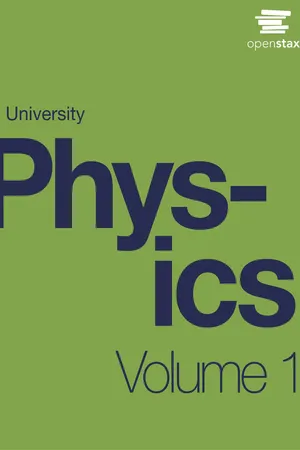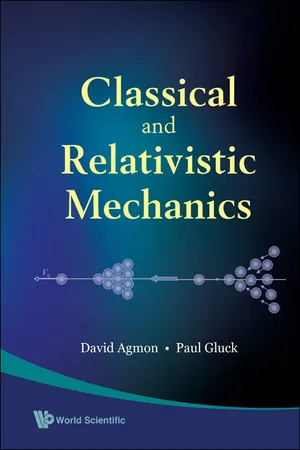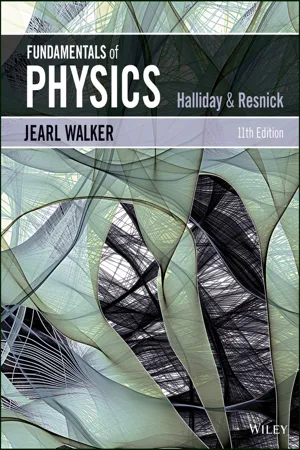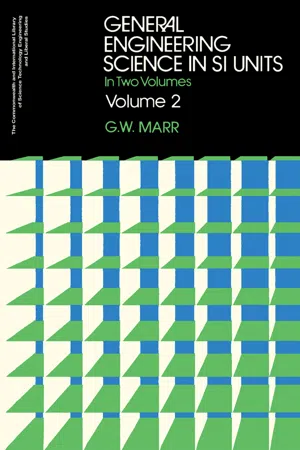Physics
Average Velocity and Instantaneous Velocity
Average velocity is the total displacement of an object divided by the total time taken. It gives an overall picture of an object's motion. Instantaneous velocity, on the other hand, is the velocity of an object at a specific instant in time. It is determined by calculating the slope of the tangent to the position-time graph at that instant.
Written by Perlego with AI-assistance
Related key terms
1 of 5
10 Key excerpts on "Average Velocity and Instantaneous Velocity"
- eBook - PDF
- William Moebs, Samuel J. Ling, Jeff Sanny(Authors)
- 2016(Publication Date)
- Openstax(Publisher)
The average speed, however, is not zero, because the total distance traveled is greater than zero. If we take a road trip of 300 km and need to be at our destination at a certain time, then we would be interested in our average speed. However, we can calculate the instantaneous speed from the magnitude of the instantaneous velocity: (3.6) Instantaneous speed = | v(t) | . If a particle is moving along the x-axis at +7.0 m/s and another particle is moving along the same axis at −7.0 m/s, they have different velocities, but both have the same speed of 7.0 m/s. Some typical speeds are shown in the following table. Chapter 3 | Motion Along a Straight Line 113 Speed m/s mi/h Continental drift 10 −7 2 × 10 −7 Brisk walk 1.7 3.9 Cyclist 4.4 10 Sprint runner 12.2 27 Rural speed limit 24.6 56 Official land speed record 341.1 763 Speed of sound at sea level 343 768 Space shuttle on reentry 7800 17,500 Escape velocity of Earth* 11,200 25,000 Orbital speed of Earth around the Sun 29,783 66,623 Speed of light in a vacuum 299,792,458 670,616,629 Table 3.1 Speeds of Various Objects *Escape velocity is the velocity at which an object must be launched so that it overcomes Earth’s gravity and is not pulled back toward Earth. Calculating Instantaneous Velocity When calculating instantaneous velocity, we need to specify the explicit form of the position function x(t). For the moment, let’s use polynomials x(t) = At n , because they are easily differentiated using the power rule of calculus: (3.7) dx(t) dt = nAt n − 1 . The following example illustrates the use of Equation 3.7. Example 3.3 Instantaneous Velocity Versus Average Velocity The position of a particle is given by x(t) = 3.0t + 0.5t 3 m . a. Using Equation 3.4 and Equation 3.7, find the instantaneous velocity at t = 2.0 s. b. Calculate the average velocity between 1.0 s and 3.0 s. Strategy Equation 3.4 give the instantaneous velocity of the particle as the derivative of the position function. - eBook - PDF
- Michael Tammaro(Author)
- 2019(Publication Date)
- Wiley(Publisher)
Thus, speed indicates how fast an object is moving, but contains no information about its direction of motion. Velocity, on the other hand, indicates both how fast the object is moving and the direction of its motion. Suppose an object executes a displacement x x x 0 ∆ = − in a time t t t 0 ∆ = − . (Thus, t is the time when the position is x and t 0 is the time when the position is x 0 .) We define average velocity, v avg , as the displacement divided by the elapsed time: v x t x x t t avg 0 0 = ∆ ∆ = − − (2.2.2) In Animated Figure 2.2.2, a runner travels to the right along the sidewalk (in the positive x direction), turns around at the yield sign, and runs back to the lamppost. What are the aver- age speed and average velocity of the runner as he runs from the stop sign to the yield sign? Activate the animation in the figure. The clock starts as the runner passes the stop sign and stops as he arrives at the yield sign with an elapsed time of 8.50 s. As we have seen, his average speed is / / ( ) ( ) 53.0 m 8.50 s 6.24 m s = . What is his average velocity? The runner’s displacement is x 53.0 m ∆ = + , so by Equation 2.2.2 we have / v x t 53.0 m 8.50 s 6.24 m s avg = ∆ ∆ = + = + Numerically, this is the same as the average speed, but the average velocity is a vector quantity, and the plus sign indicates that the average velocity is in the positive x direction. Animated Figure 2.2.2 The runner runs to the yield sign, turns around, and runs back. His initial position is at the stop sign, and his final position is at the yield sign. Labeled here is his displacement x ∆ as he runs from the stop sign to the yield sign. I N T E R A C T I V E F E A T U R E I N T E R A C T I V E F E A T U R E I N T E R A C T I V E F E A T U R E Instantaneous Velocity | 49 An object moving along the x axis has an average velocity of +3.45 cm/s during a partic- ular 22.3-s time interval. - David Halliday, Jearl Walker, Patrick Keleher, Paul Lasky, John Long, Judith Dawes, Julius Orwa, Ajay Mahato, Peter Huf, Warren Stannard, Amanda Edgar, Liam Lyons, Dipesh Bhattarai(Authors)
- 2020(Publication Date)
- Wiley(Publisher)
Your average velocity is the slope of the straight line connecting those points; that is, v avg is the ratio of the rise (Δx = 10.4 km) to the run (Δt = 0.62 h), which gives us v avg = 16.8 km/h. (d) Suppose that to put fuel in the ute, pay for it, and walk back to the ute takes you another 45 min. What is your average speed from the beginning of your drive to your return to the ute with the fuel? KEY IDEA Your average speed is the ratio of the total distance you move to the total time interval you take to make that move. Calculation The total distance is 8.4 km + 2.0 km + 2.0 km = 12.4 km. The total time interval is 0.12 h + 0.50 h + 0.75 h = 1.37 h. Thus, equation 2.3 gives us s avg = 12.4 km 1.37 h = 9.1 km∕h. (Answer) 2.2 Instantaneous velocity and speed LEARNING OBJECTIVES After reading this module, you should be able to: 2.2.1 given a particle’s position as a function of time, calculate the instantaneous velocity for any particular time 2.2.2 given a graph of a particle’s position versus time, determine the instantaneous velocity for any particular time 2.2.3 identify speed as the magnitude of the instantaneous velocity. KEY IDEAS • The instantaneous velocity (or simply velocity) v of a moving particle is v = lim t→0 Δx Δt = dx dt , where Δx = x 1 − x 0 and Δt = t 1 − t 0 . • The instantaneous velocity (at a particular time) may be found as the slope (at that particular time) of the graph of x versus t. • Speed is the magnitude of instantaneous velocity. Pdf_Folio:14 14 Fundamentals of physics Instantaneous velocity You have now seen two ways to describe how fast something moves: average velocity and average speed, both of which are measured over a time interval Δt. However, the phrase ‘how fast’ more commonly refers to how fast a particle is moving at a given instant — its instantaneous velocity (or simply velocity) v. The velocity at any instant is obtained from the average velocity by shrinking the time interval Δt closer and closer to 0.- eBook - PDF
- David Agmon, Paul Gluck;;;(Authors)
- 2009(Publication Date)
- WSPC(Publisher)
We have then V =S/t = (V l +V 2 )/2. (Can you prove and illustrate this result on a V versus t graph?) 2.3 Instantaneous velocity Average velocity has limited value, as it gives only partial information. Full information about the motion of a body would be provided if we knew its velocity at every instant of time. Defining instantaneous velocity requires the following limiting process. Let At— >0. Then Ax—>0 will also approach zero, but of course not necessarily at the same rate, so that in the definition of the instantaneous velocity Ax dx V = lim — = — (2.4) A '^°° At dt the ratio tends to a finite quantity. We recognize in this limiting process the definition of a derivative: instantaneous velocity is the time derivative of the displacement. Example 2 Average and instantaneous velocity. The position of a moving body is given by the function x(t)=at. Since x is in meters and t in seconds, the constant a has units of length divided by time squared. Choose a -5 m/s 2 . (a) Sketch the graph x(t) and compute the average velocity between t = 10 s and t = 11 s. Give a geometrical interpretation of the result, (b) Write a general expression for the average velocity in the interval between t = 10 s and t = (10+A0 s and calculate it for 3 values of At: 0.1, 0.01, 0.001. (c) Calculate the instantaneous velocity at t = 10 s. Solution (a) Substituting, we get x,(10) = 500m , x 2 (11) = 605m , hence Ax - x 2 -x x = 105m, At = Is and V = Ax I At = 105m/s .This velocity is the ratio of two sides of the triangle whose hypotenuse is the cord AB, as shown. (b) Substituting we get i *2 V/ k AJ At B AJC L^L_ _i_ Chapter 2 Kinematics 29 x 2 (0 + At) = (500 + lOOAt + 5At 2 )rn Ax = x 2 -x,= (500 + lOOAf + 5At 2 ) - 500 -100A* + 5At 2 so that V=Ax/A/ = (l00Af + 5Ar 2 )/A; = 100 + 5Af m/s For Af =0.1 s we obtain V -100 + 5Af = 100.5 m/s. For Af = 0.01s wehave V = 100 + 5A; = 100.05m/s . For At = 0.001s we get V = 100 + 5At = 100.005 m/s . - eBook - PDF
- John D. Cutnell, Kenneth W. Johnson, David Young, Shane Stadler, Heath Jones, Matthew Collins, John Daicopoulos, Boris Blankleider(Authors)
- 2020(Publication Date)
- Wiley(Publisher)
Dividing the displacement Δ x of the car by the elapsed time Δt gives the average velocity of the car. It is customary to denote the average value of a quantity by placing a horizontal bar above the symbol representing the quantity. The average velocity, then, is written as v, as specified in equation 2.2. Definition of average velocity Average velocity = Displacement Elapsed time v = x - x 0 t - t 0 = Δ x Δt (2.2) SI unit of average velocity: metre per second (m/s) CHAPTER 2 Kinematics in one dimension 29 FIGURE 2.2 The boats in this photograph are travelling in opposite directions; in other words, the velocity of one boat points in a direction that is opposite to the velocity of the other boat. Source: © Michael Dietrich / Age Fotostock Equation 2.2 indicates that the unit for average velocity is the unit for length divided by the unit for time, or metres per second (m/s) in SI units. Velocity can also be expressed in other units, such as kilometres per hour (km/h) or miles per hour (mi/h). Average velocity is a vector that points in the same direction as the displacement in equation 2.2. Figure 2.2 illustrates that the velocity of an object confined to move along a line can point either in one direc- tion or in the opposite direction. As with displacement, we will use plus and minus signs to indicate the two possible directions. If the displacement points in the positive direction, the average velocity is positive. Conversely, if the displacement points in the negative direction, the average velocity is negative. Example 2 illustrates these features of average velocity. EXAMPLE 2 The world’s fastest jet‐engine car Andy Green in the car ThrustSSC set a world record of 341.1 m/s (763 mi/h) in 1997. The car was powered by two jet engines, and it was the first one officially to exceed the speed of sound. To establish such a record, the driver makes two runs through the course, one in each direction, to nullify wind effects. - eBook - PDF
General Engineering Science in SI Units
The Commonwealth and International Library: Mechanical Engineering Division
- G. W. Marr, N. Hiller(Authors)
- 2013(Publication Date)
- Pergamon(Publisher)
Section 2 Velocity and Acceleration 2.1. Motion When the position of one body relative to another is continuously changing the bodies are said to be in relative motion. Motion, in fact, is always relative. In very many cases we are concerned with the motion of a body relative to the earth, and in such cases the word relative is generally omitted. We are accustomed to refer-ring simply to the motion of a motor vehicle or aircraft. We may say, for example, that a caj* is travelling at a speed of 30 km/h. When we do so, it must be understood that the speed is relative to the earth. 2.2. Velocity The velocity of a body is the rate at which the body is changing its position. Because direction is involved, velocity is a vector quantity. The magnitude, or numerical value, of a velocity is called the speed. The average speed of a body during a given interval of time IS measured by the ratio total distance^raven.d in given time W h e n a body travels equal distances during equal intervals of time, what-ever the magnitude of the time interval, the body is said to travel with constant speed. A velocity may change because of change in speed, or in the direction of motion or because of a change v in both of these. 32 VELOCITY AND ACCELERATION When a body moves in such a way that its velocity does not change, it is said to move with constant, or uniform, velocity. Hence to move with uniform velocity, a body must travel at constant speed in a straight line. EXAMPLE. A vehicle travels a distance of 840 m in 30 sec. Express its average speed in km/h. Distance travelled = 840 m = 0-84 km. 30 s = ai 0-84 km Time interval = 30s = g§öö h = iiö-h .*. average speed — —j = 100-8 km/h. EXAMPLE. The straight-line distance between two towns, A and B, is 49 km. Town A is due north-west from B. The road distance between the towns is 56 km. A motorist leaves A at 13.20 h and arrives at B at 14.10 h. Calculate (a) his average speed; (b) his average velocity. - eBook - PDF
- David Halliday, Robert Resnick, Jearl Walker(Authors)
- 2018(Publication Date)
- Wiley(Publisher)
● When a particle has moved from position x 1 to position x 2 during a time interval Δt = t 2 − t 1 , its average velocity during that interval is v avg = Δx Δt = x 2 − x 1 t 2 − t 1 . ● The algebraic sign of v avg indicates the direction of motion (v avg is a vector quantity). Average velocity does not depend on the actual distance a particle moves, but instead depends on its original and final positions. ● On a graph of x versus t, the average velocity for a time interval Δt is the slope of the straight line connecting the points on the curve that represent the two ends of the interval. ● The average speed s avg of a particle during a time interval Δt depends on the total distance the particle moves in that time interval: s avg = total distance Δt . Learning Objectives After reading this module, you should be able to . . . 2.01 Identify that if all parts of an object move in the same direction and at the same rate, we can treat the object as if it were a (point-like) particle. (This chapter is about the motion of such objects.) 2.02 Identify that the position of a particle is its location as read on a scaled axis, such as an x axis. 2.03 Apply the relationship between a particle’s displacement and its initial and final positions. 2.04 Apply the relationship between a particle’s average velocity, its displacement, and the time interval for that displacement. 2.05 Apply the relationship between a particle’s average speed, the total distance it moves, and the time inter- val for the motion. 2.06 Given a graph of a particle’s position versus time, determine the average velocity between any two par- ticular times. 14 CHAPTER 2 MOTION ALONG A STRAIGHT LINE Motion The world, and everything in it, moves. Even seemingly stationary things, such as a roadway, move with Earth’s rotation, Earth’s orbit around the Sun, the Sun’s orbit around the center of the Milky Way galaxy, and that galaxy’s migration relative to other galaxies. - eBook - PDF
General Engineering Science in SI Units
In Two Volumes
- G. W. Marr, N. Hiller(Authors)
- 2016(Publication Date)
- Pergamon(Publisher)
Section 2 Velocity and Acceleration 2.1. Motion When the position of one body relative to another is continuously changing the bodies are said to be in relative motion. Motion, in fact, is always relative. In very many cases we are concerned with the motion of a body relative to the earth, and in such cases the word relative is generally omitted. We are accustomed to refer-ring simply to the motion of a motor vehicle or aircraft. We may say, for example, that a car is travelling at a speed of 30 km/h. When we do so, it must be understood that the speed is relative to the earth. 2.2. Velocity The velocity of a body is the rate at which the body is changing its position. Because direction is involved, velocity is a vector quantity. The magnitude, or numerical value, of a velocity is called the speed. The average speed of a body during a given interval of time is measured by the ratio total distance um^d m given time w h e n a body travels equal distances during equal intervals of time, what-ever the magnitude of the time interval, the body is said to travel with constant speed. A velocity may change because of change in speed, or in the direction of motion or because of a change in both of these. 32 VELOCITY AND ACCELERATION When a body moves in such a way that its velocity does not change, it is said to move with constant, or uniform, velocity. Hence to move with uniform velocity, a body must travel at constant speed in a straight line. EXAMPLE. A vehicle travels a distance of 840 m in 30 sec. Express its average speed in km/h. Distance travelled = 840 m = 0-84 km. Time interval = 3 0 s = a|ööh = 1 ^-h 0-84 km .·. average speed = —j I2Ö h = 100-8 km/h. EXAMPLE. The straight-line distance between two towns, A and B, is 49 km. Town A is due north-west from B. The road distance between the towns is 56 km. A motorist leaves A at 13.20 h and arrives at B at 14.10 h. Calculate (a) his average speed; (b) his average velocity. - eBook - PDF
- David Halliday, Robert Resnick, Jearl Walker(Authors)
- 2020(Publication Date)
- Wiley(Publisher)
. . which can be rewritten in unit-vector notation as v → = v x i ˆ + v y j ˆ + v z k ˆ , where v x = dx/dt, v y = dy/dt, and v z = dz/dt. ● The instantaneous velocity v → of a particle is always directed along the tangent to the particle’s path at the particle’s position. Key Ideas 4.04 Identify that velocity is a vector quantity and thus has both magnitude and direction and also has components. 4.05 Draw two-dimensional and three-dimensional veloc- ity vectors for a particle, indicating the components along the axes of the coordinate system. ● If a particle undergoes a displacement Δ r → in time inter- val Δt, its average velocity v → avg for that time interval is v → avg = Δ r → Δt . ● As Δt is shrunk to 0, v → avg reaches a limit called either the velocity or the instantaneous velocity v → : v → = d r → dt , 4-2 Average Velocity and Instantaneous Velocity 56 CHAPTER 4 MOTION IN TWO AND THREE DIMENSIONS Average Velocity and Instantaneous Velocity If a particle moves from one point to another, we might need to know how fast it moves. Just as in Chapter 2, we can define two quantities that deal with “how fast”: Average Velocity and Instantaneous Velocity. However, here we must con- sider these quantities as vectors and use vector notation. If a particle moves through a displacement Δ r → in a time interval Δt, then its average velocity v → avg is average velocity = displacement time interval , or v → avg = Δ r → Δt . (4-8) This tells us that the direction of v → avg (the vector on the left side of Eq. 4-8) must be the same as that of the displacement Δ r → (the vector on the right side). Using Eq. 4-4, we can write Eq. 4-8 in vector components as v → avg = Δxi ˆ + Δyj ˆ + Δzk ˆ Δt = Δx Δt i ˆ + Δy Δt j ˆ + Δz Δt k ˆ . (4-9) For example, if a particle moves through displacement (12 m)i ˆ + (3.0 m)k ˆ in 2.0 s, then its average velocity during that move is v → avg = Δ r → Δt = (12 m)i ˆ + (3.0 m)k ˆ 2.0 s = (6.0 m/s)i ˆ + (1.5 m/s)k ˆ . - eBook - PDF
- David Halliday, Robert Resnick, Jearl Walker(Authors)
- 2021(Publication Date)
- Wiley(Publisher)
Displacement If a particle moves so that its position vector changes from r → 1 to r → 2 , the particle’s displacement Δ r → is Δ r → = r → 2 − r → 1 . (4.1.2) The displacement can also be written as Δ r → = ( x 2 − x 1 ) ˆ i + ( y 2 − y 1 ) ˆ j + ( z 2 − z 1 )k ̂ (4.1.3) = Δx ˆ i + Δy ˆ j + Δz k ̂ . (4.1.4) Average Velocity and Instantaneous Velocity If a particle undergoes a displacement Δ r → in time interval Δt, its average velocity v → avg for that time interval is v → avg = Δ r → ____ Δt . (4.2.1) As ∆t in Eq. 4.2.1 is shrunk to 0, v → avg reaches a limit called either the velocity or the instantaneous velocity v → : v → = d r → ___ dt , (4.2.3) which can be rewritten in unit-vector notation as v → = v x ˆ i + v y ˆ j + v z k ̂ , (4.2.4) where v x = dx /dt, v y = dy/dt, and v z = dz /dt. The instantaneous velocity v → of a particle is always directed along the tangent to the particle’s path at the particle’s position. Average Acceleration and Instantaneous Accele- ration If a particle’s velocity changes from v → 1 to v → 2 in time interval ∆t, its average acceleration during ∆t is a → avg = v → 2 − v → 1 ________ Δt = Δ v → ____ Δt . (4.3.1) As ∆t in Eq. 4.3.1 is shrunk to 0, a → avg reaches a limiting value called either the acceleration or the instantaneous acceleration a → : a → = d v → ___ dt . (4.3.2) In unit-vector notation, a → = a x ˆ i + a y ˆ j + a z k ̂ , (4.3.3) where a x = dv x /dt, a y = dv y /dt, and a z = dv z /dt. Review & Summary Projectile Motion Projectile motion is the motion of a par- ticle that is launched with an initial velocity v → 0 . During its flight, the particle’s horizontal acceleration is zero and its vertical acceleration is the free-fall acceleration ‒g.
Index pages curate the most relevant extracts from our library of academic textbooks. They’ve been created using an in-house natural language model (NLM), each adding context and meaning to key research topics.









